Biosecurity in Antarctica

As Antarctica's popularity continues to grow, the need to protect its ecosystems is ever-important. Simple biosecurity procedures ensure responsible visits.
Discover MoreSpecial Offers Available: Swoop has access to the widest range of offers and can help you find the right trip, cabin, & price.
Expert impartial advice at no extra cost: no-nonsense advice on 1500 voyages across 30 ships
The Antarctic Experts. No Compromises: there’s no question we can’t answer
The only B Corp certified Antarctic specialist: so your adventures can be a force for good
A full concierge service, unlike booking direct: we leave nothing to chance in delivering your perfect trip
Special Offers Available: Swoop has access to the widest range of offers and can help you find the right trip, cabin, & price.
Expert impartial advice at no extra cost: no-nonsense advice on 1500 voyages across 30 ships
The Antarctic Experts. No Compromises: there’s no question we can’t answer
The only B Corp certified Antarctic specialist: so your adventures can be a force for good
A full concierge service, unlike booking direct: we leave nothing to chance in delivering your perfect trip
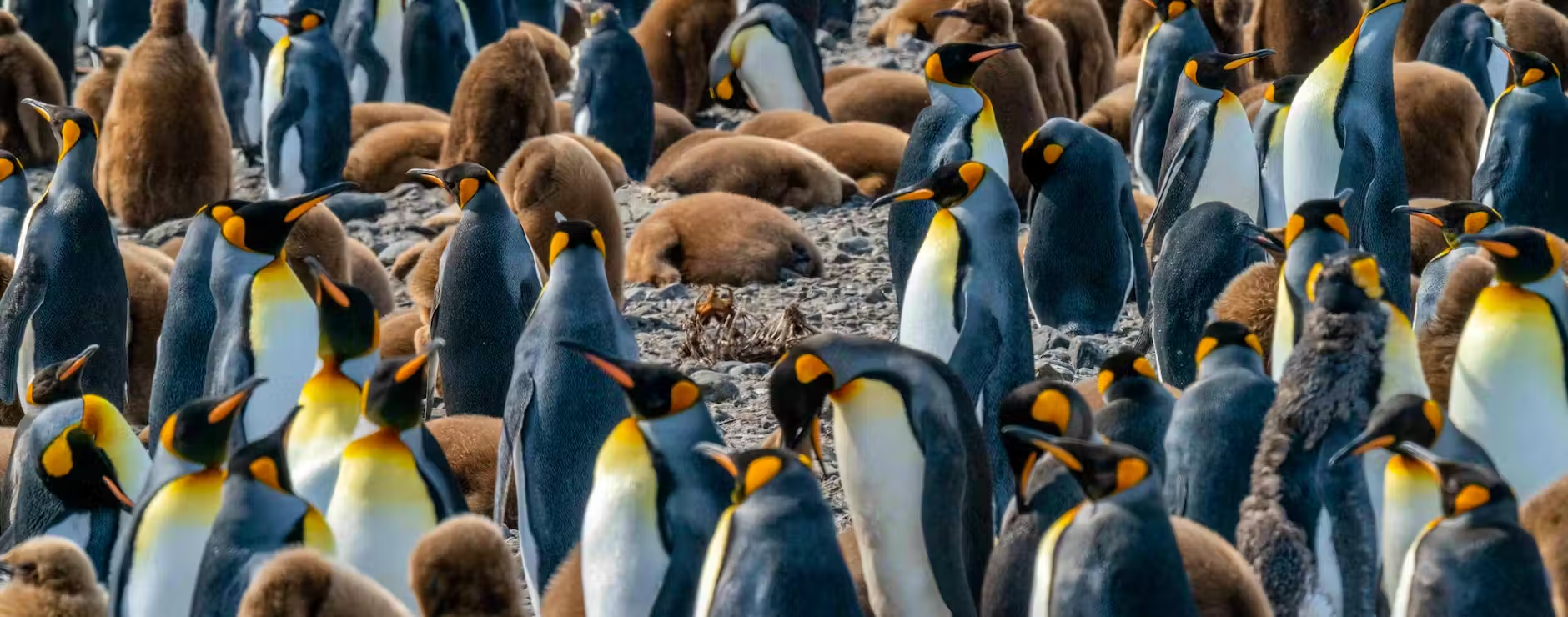
The statistics alone simply can’t do justice to how extraordinary the wildlife of South Georgia is. At the height of the breeding season, there is said to be more wildlife per square foot than in any other place on the planet. On your voyage to this incredible island, you will experience the greatest density of wildlife on Earth.
With no permanent human residents and only a smattering of government officials and scientists dotted around the island, the wildlife here is largely devoid of fear. This leads to some of the most extraordinary wildlife encounters on the planet.
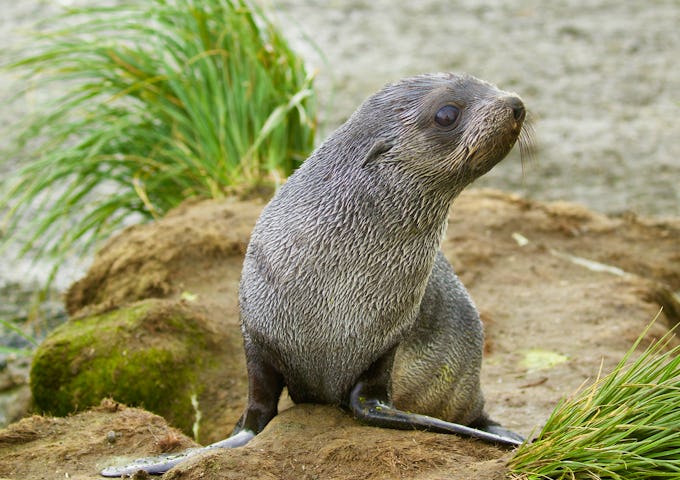
Fur Seal Pup, South Georgia
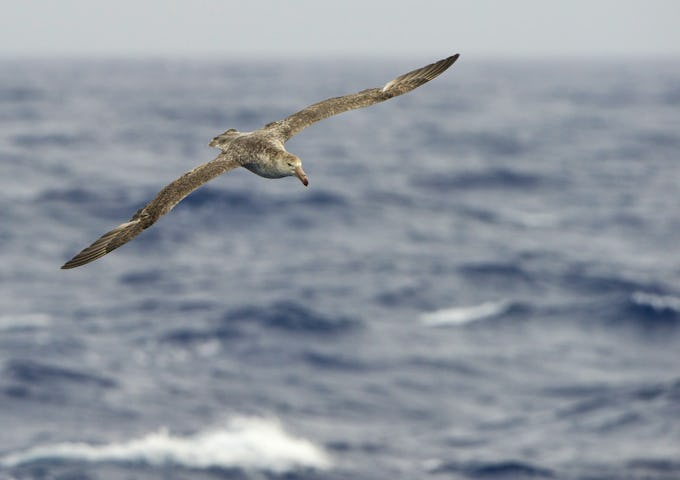
Giant petrel, South Georgia
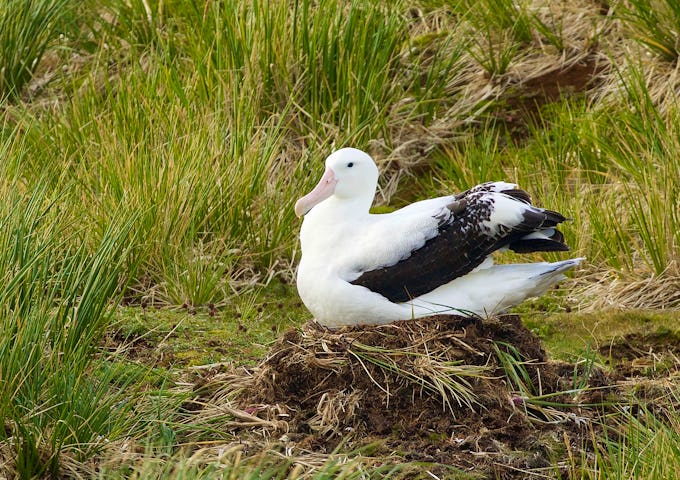
Wandering Albatross at Prion Island, South Georgia
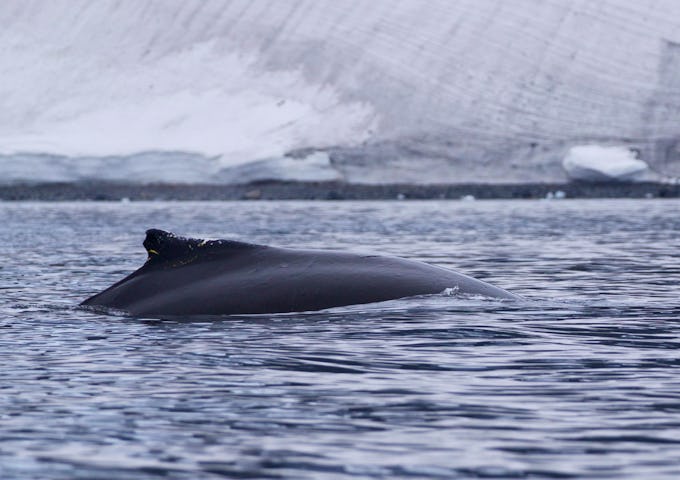
Humpback Whale, South Georgia
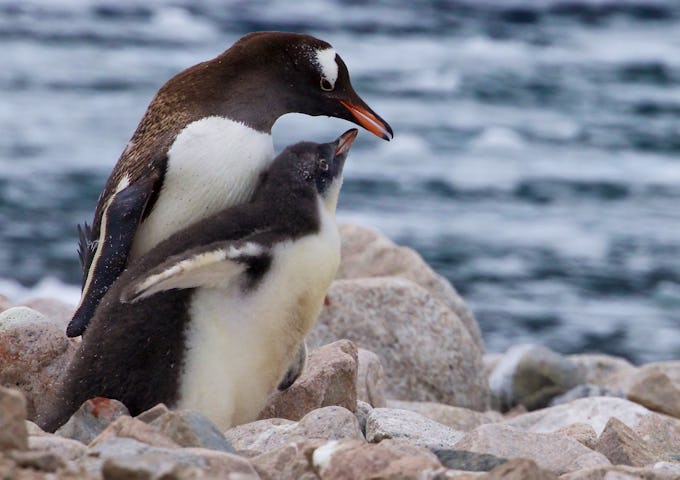
Gentoo Penguins, South Georgia
South Georgia is so photogenic, we strongly recommend you bring spare batteries on shore with you and also travel with several memory cards to ensure you don't run out!
The number of penguins that inhabit the islands is overwhelming. There are considered to be 7 million individual penguins on South Georgia, largely made up of three dominant species.
King penguins with lurking giant petrel
Closely related to the emperor penguin, the elegant king penguin is the second largest penguin standing at 25-29 inches (65-75cm). King penguins are found on 7 of the sub-Antarctic islands with a breeding population of around 1-1.5 million pairs. There are thought to be around 450,000 breeding pairs across South Georgia and the South Sandwich Islands.
Like the emperor penguin, the king lays one egg and this is carried around on the feet of both parents until it hatches 55 days later. The breeding season lasts 14-16 months including rearing the chick. This is much longer than other species which means they only breed twice every three years. This unusual breeding cycle means that whatever time of the season you are visiting, you will see birds of different ages including the gloriously fluffy brown chicks.
The sheer volume of king penguins can be absolutely mind-boggling. At the largest rookery in St Andrew’s Bay (pictured), there are an estimated 150,000 pairs. They stretch off into the distance as far as the eye can see. It is almost impossible to take a photograph that accurately represents the spectacle.
This characterful bird is known for its yellow-tasselled plumage, which distinguishes it from fellow penguins (although it is similar to the slightly smaller rockhopper penguin). Their astonishing overall number of breeding pairs (11.8 million) are mainly concentrated throughout South Georgia, where you're bound to catch sight of some of the over 5 million pairs.
One of the most interesting things about this penguin is its unusual breeding cycle. Two eggs are produced, but the first is 40% smaller than the second. The first is often not fully incubated and is usually lost/removed from the next before the second egg hatches. Only one chick is ever raised.
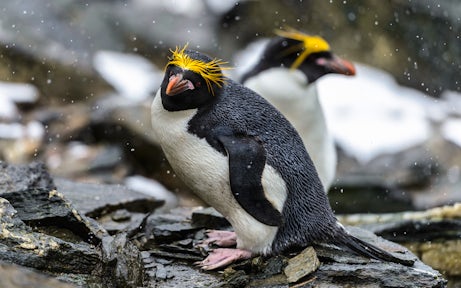
The gentoo penguin is the most common penguin to see during an expedition to the Antarctic Peninsula, despite surprisingly being one of the least numerous penguins in Antarctica overall. A further 100,000 are found in South Georgia and 70,000 in the Falkland Islands. Swoop staff have spotted the odd gentoo wandering through the ruins of the whaling station at Grytviken!
The gentoo is easily identifiable by the white patch above its eye, which wraps around like a pair of large white headphones or a headband. They have a distinctive bright orange beak and feet. At 24 inches (61cm tall) they are taller than adelies and chinstraps, and adults generally weigh around 13lb (6kg). They tend to fish within 2.5 miles of their nests but can dive up to 495 ft (225m).

Gentoo penguin in the tussac grass at Godthul
Hard to miss – being a dominant force on many beaches – the island's seal population is truly staggering.
There are well over 2 million southern fur seals, with 95% of the world's population converging on South Georgia each summer. This is a wildlife success story as avaricious sealers all but wiped out the fur seal population in the 18th and 19th centuries. After legislation was put into place to protect them, the population made a strong recovery.
Found in such thick densities in December at the height of the breeding season, going ashore can be a real challenge and at times it simply isn’t practical to try to do so. Despite their doe-eyed looks, caution when walking amongst fur seals is strongly advised as they can be aggressive - please maintain a safe distance at all times.
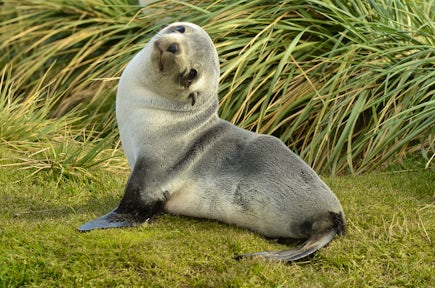
Fur seal pup, South Georgia
Elephant seals on the beaches of South Georgia
On top of the fur seals, half of the world's population of southern elephant seals (more than 400,000 individual animals) also come to South Georgia to breed.
Their curious name comes from their vast size and the large proboscis belonging to the massive adult males. Males elephant seals can be over 20 feet/ 6m long and weigh up to 8,800 pounds (4,000kg), dwarfing the females. Visitors early in the season might catch the huge beachmaster males violently defending their harem.
At any time in the season, it’s great fun to watch these cantankerous seals interact with each other, as well as passing penguins. Huddling for social thermoregulation, you often spot these huge animals clambering on top of each other, accompanied by a cacophony of indignant barks from those being trampled on. They are also noticeably gaseous (from both ends!), which contributes to the overall din!
Wandering albatross nesting on Prion Island
A black-browed albatross
A haven for birdlife, with an estimated population of well over 65 million birds, South Georgia is the world’s most important seabird breeding site.
There are over 30 known bird species on the island, including half the world’s population of Antarctic prions and 250,000 albatrosses of different species. One-fifth of the world’s wandering albatrosses – the bird with the largest wingspan of all at over 3 metres – also calls this small island home.
For bird enthusiasts, Prion Island hosts nesting wandering albatross sites, which are accessible via a series of boardwalks that are sometimes zealously guarded by fur seals. Please note that access to the island is strictly controlled; it's closed to all visitors between 20th November - 7th January (inclusive).
Birders must also look out for the two endemic species found here. The South Georgia pipit is the only subantarctic songbird. The second is the unassuming-looking South Georgia pintail, a carnivorous duck, which is known to feed on dead seals!
St. Andrew’s Bay South Georgia probably stands out as the most memorable. To be able to walk among the hundreds of thousands of king penguins, elephant seals, fur seals, albatross and other sea birds with a backdrop of glaciers and mountains ending at the sea was beyond imagination. Read the full review
Travelled: February 2025
Michele Krantz - USA
Most memorable moment? The thrilling view of the expansive collection of king penguins on South Georgia Island - St. Andrew's Bay and Gold Harbor. Read the full review
Travelled: January 2025
Alisa Schreier - USA
Most memorable moment? Seeing the thousands and thousands of penguins at Salisbury Plain, South Georgia.
Travelled: January 2025
Andrew Mail - Canada
Most memorable moment? Seeing the most beautiful ice and 7 types of penguins. Read the full review
Travelled: January 2025
Amy M Mundt - USA
10/10 - Everything was perfect - the excursions, the guides, the ship - each place was different and we saw every animal on our checklist. Read the full review
Travelled: January 2025
Robin Schelstraete - USA
Most memorable moment? Seeing the breathtaking volume of penguins in South Georgia and the thrill of paddling on the water and seeing seals on an ice sheet at eye level! Read the full review
Travelled: January 2025
Ibby Carothers - USA
Bottom line, I'd go back to South Georgia as a destination in and of itself - we both thought it surpassed Antarctica on a number of levels (scenery, wildlife density, historical, etc).
Travelled: January 2025
John Wilke - New Zealand
10/10 - Every day just got better till our last, which was a bit snowed out and windy at the end. Most memorable moment? All the abundant wildlife, including whales and penguin colonies. Read the full review
Travelled: December 2024
Paul Kortopates - USA
Most memorable moment? The immense penguin colony(s) in St. Andrews Bay on South Georgia. Read the full review
Travelled: December 2024
Walter Blom - Netherlands
10/10 - I would do it all over again. Most memorable moment? Seeing the masses of frolicking penguins and seal pups in South Georgia.
Travelled: December 2024
Colin Isenman - UK
Most memorable moment? Watching thousands of moulting king penguins lining the meltwater streams from Nordenschild Glacier at St Andrews Bay, South Georgia. Wow! Read the full review
Travelled: December 2024
Drew Wilson - USA
The splendour of the scenery in Antarctica and the enormous amount of wildlife on South Georgia was still breathtaking and even more impressive than any photo could ever convey. I left Antarctica, especially, disappointed in the quality of my photos - they completely fail to convey the scale and grandeur of the place and I'm pretty sure that's not just a reflection of my photography skills. Read the full review
Travelled: December 2024
Drew Wilson - USA
Most memorable moment? Standing above a colony of over 300,000 king penguins at Saint Andrews Bay, South Georgia. Read the full review
Travelled: December 2024
Karen Downing - United States Minor Outlying Islands
Most memorable moment? The penguins of South Georgia. Read the full review
Travelled: December 2024
Dan Salter - UK
Most memorable moment? On shore with the wildlife in South Georgia. Read the full review
Travelled: December 2024
Malcolm Pryor - UK
Most memorable moment? The hundreds of thousands of king penguins, plus elephant seals and fur seals at South Georgia Island and then the majesty of the icebergs, ocean, mountains, and glaciers at the Antarctic Peninsula. Read the full review
Travelled: November 2024
Rebecca Melonakos - USA
Most memorable moments? Standing on South George island among a million king penguins and seals and kayaking among beautiful iceberg forms. Read the full review
Travelled: November 2024
Stephen Sharp - USA
My advice? Don't miss South Georgia. My most memorable moment was being with tens of thousands of king penguins on South Georgia. Read the full review
Travelled: November 2024
Silvia Schriever - Canada
10/10 - It was an amazing lifetime experience. Most memorable moment? Being present with the abundance of penguins, elephants, seals and albatross birds, to be part of their lives and be able to appreciate how they live and survive. Read the full review
Travelled: October 2024
Cheong Kin Seng - Malaysia
Most memorable moment? When we landed on Fortuna Bay in South Georgia surrounded by king penguins and seal pups. Read the full review
Travelled: March 2024
Padmaja Sakhamuri - UK
10/10 - Outstanding adventure, Antarctica is so wonderful and South Georgia was something else. We saw a lot of it in documentaries, but seeing it in real life was like standing amidst a National Geographic documentary. Read the full review
Travelled: March 2024
Prasanth Sakhamuri - UK
I find it impossible to choose one memorable moment. All of the wildlife on South Georgia, albatross fledglings testing out their wings on West Falklands, landing at Wild Point on Elephant Island...I could go on and on and on. Read the full review
Travelled: March 2024
Linda Smith - UK
Most memorable moment? Seeing thousands and thousands of penguins in South Georgia. Read the full review
Travelled: February 2024
Farhad Vatcha - USA
Most memorable moment? The king penguin colony on South Georgia Island and the albatross and rockhopper penguins on one of the Falklands Islands. The naturalists’ enthusiasm, knowledge and willingness to share their knowledge exceeded expectations. Read the full review
Travelled: February 2024
Patricia Coughlan - USA
There are so many memorable moments!! Fortuna Bay surrounded by thousands of king penguins and hundreds of juvenile fur seals. The history at Grytviken, with the story of Shackleton. Read the full review
Travelled: February 2024
Doug Pemberton - Canada
Most memorable moment? King penguin colony with fur seal pups playing in the surf. Read the full review
Travelled: February 2024
Franz Scherubl - Canada
Most memorable moment? The numerous wildlife encounters. Really enjoyed seeing all the different species of seals and penguins in their natural habitat. Read the full review
Travelled: January 2024
David Flack - Japan
10/10 - Being in Antarctica was an amazing experience - but South Georgia and the Falklands added another level to the trip, especially for wildlife. Read the full review
Travelled: December 2023
Lesley Croskery - South Africa
There were so many memorable moments. Seeing a pod of Killer Whales, setting foot on the 7th continent, the elephant seal pups looking up with those adorable eyes, the king penguin chicks running and flapping around trying to shake off their down coats. What a trip! Read the full review
Travelled: November 2023
Neil Gibson - Australia
So much wildlife - penguins, sea birds, whales, dolphins - and beautiful icebergs that were all different. Nature is so beautiful & a brilliant artist. Add to that the wonderful scenery & you are in heaven. Loved it. Read the full review
Travelled: March 2023
Cecilia Griffin - UK
Most memorable moment? The first day on South Georgia. The abundance of life totally unfazed by humans. Read the full review
Travelled: December 2022
James Castleden - Hungary
Spending 20 days with the abundance of wildlife we experienced convinced me that penguins should be at the top of the food chain - not humans. They really have the life - and penguins just make you smile. Read the full review
Travelled: December 2022
Gerry Garber - USA
The wildlife was amazing! There is such an abundance and variety of everything on shore and off. Even our at sea days were full of sea birds around the ship and whales close by. We saw thousands of penguins and seals everywhere we went. With the kayaking and zodiac cruises we got perspective of animals from the water as well! Read the full review
Travelled: November 2022
Jennifer Crews - Canada
Being completely engulfed by amazing wildlife in such a close proximity. It was a sensory overload in every sense of the word. Read the full review
Travelled: November 2022
Helena Polackova - UK
We discovered why South Georgia is called The Serengeti of the Antarctic! We were surrounded by hundreds of thousands penguins, fur seals, elephant seals to such an extent that it was sometimes too dangerous to make a zodiac landing as the wildlife on shore was too dense. The landscape and the true wilderness of South Georgia is breathtaking. Read the full review
Travelled: November 2022
Helena Polackova - UK
We experienced great albatross colonies and enjoyed seeing at least seven different penguin breeds throughout the journey. Birding and whale watching opportunities on and off the ship were superb. Read the full review
Travelled: November 2022
Helena Polackova - UK
So many once in a life-time moments. I loved the wildlife encounters: tens of thousands of penguins on the beach; interactions of penguins and fur seal pups. Amazing to watch a leopard seal hunt and catch a penguin. Who knew that icebergs could be so amazing and fascinating? Read the full review
Travelled: February 2022
Scott Hunter - USA
If you love wildlife or you want to check off more birds on your list, this is a must trip. All three locations provided different wildlife experiences. If you go to the Antarctic, you must go to South Georgia and Falkland Islands. Read the full review
Travelled: February 2022
Scott Hunter - USA
Most memorable moment: the penguin colonies on South Georgia. Each time seeing the massive colonies on South Georgia I was blown away. It was beyond words. Read the full review
Travelled: February 2022
Ron Hart - USA
South Georgia was the highlight with so much wildlife and the history. The museum in Grytviken and the church were also very interesting. All the penguins, thousands of them at a time, was very overwhelming at times. Read the full review
Travelled: December 2021
Gordon Pickering - USA
If you don't visit South Georgia you're missing the 'jewel in the crown'. When we did this trip in 2008 the expedition leader in her opening remarks described South Georgia as "the place where God goes for his holidays".
Travelled: February 2018
RSW & MW - United Kingdom
Review:
Enjoying whale sightings around South Georgia is tempered by the still visible scars of the whaling industry, which once dominated this island. This is most notable at Grytiviken, where huge tanks still stand that once stored the blubber of these gentle giants. Over 175,000 whales were processed in South Georgia alone and there is some haunting footage at the museum there.
Happily, the cetacean population does seem to be slowly recovering and one recent scientific study spotted a number of blue whales, who were previously thought to have been exploited beyond the point of recovery.

The Norwegian Church amid the ruins of Grytviken whaling station
Humpbacks start to arrive from their tropical breeding grounds in November and are frequently sighted, particularly between the island and Antarctica, so keep your eyes peeled during your sea crossings. They are easily identified by their long white pectoral fins and the distinctive hump by their dorsal fin.
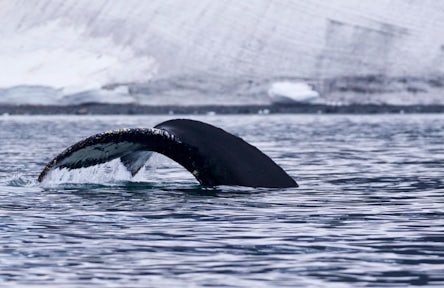
Spot humpback whales
Fin whales are also in residence, the second-largest of the great whales, particularly off the island’s southern coast. Known as the greyhounds of the sea, they are incredibly fast, easily outstripping your ship.
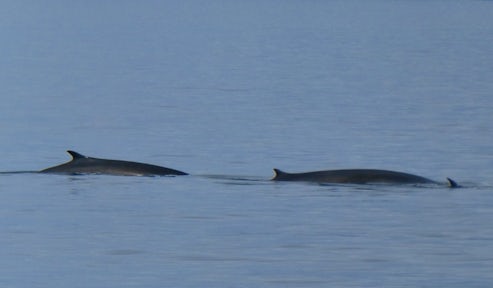
Fin whales
Though rare for visitors to see, if you are lucky enough, blue whales are easy to spot by their sheer bulk and their small curved dorsal fin located well back on the body. The dorsal fin and pigmentation pattern on the side of blue whales provide a fingerprint for identification.
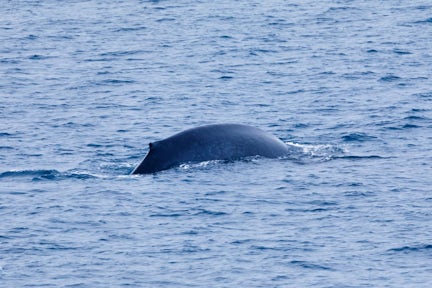
Blue whale
If you manage to get a good photo of a whale, please submit it online to https://happywhale.com – a citizen science project that aims to track these cetaceans around the globe.
On arrival at South Georgia, you will be given a mandatory briefing on biosecurity. The objective is to prevent the introduction of any non-native species. As with Antarctica, you will need to check your boots and all your clothing (looking particularly carefully at any velcro or mesh areas) for any trapped seeds or organic material.
As with Antarctica, the habitats of South Georgia are extremely fragile and at risk from invasive species. In 2018 the island was finally declared rodent free, the result of a painstaking 7-year programme to relieve the pressure on ground-nesting birds. You can read more about this programme on the Government of South Georgia's website.
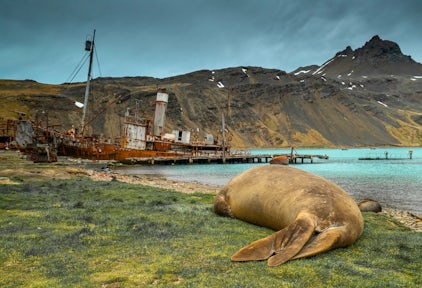
An abandoned whaling ship at Grytviken
South Georgia often surprises visitors by being just as wild, if not more so, as Antarctica. Your expedition leader will have a number of backup plans, as Plan A can often be disrupted due to challenges such as high swells or aggressive fur seals preventing safe beach landings. It is very important to “go with the flow” during your time exploring South Georgia.

As Antarctica's popularity continues to grow, the need to protect its ecosystems is ever-important. Simple biosecurity procedures ensure responsible visits.
Discover More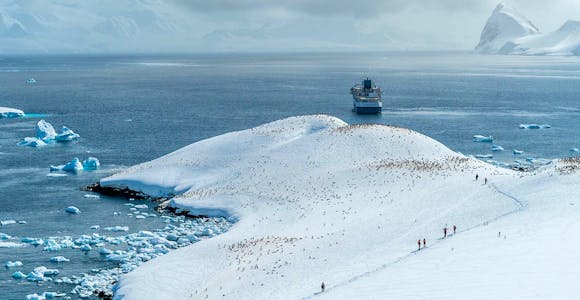
Make sure you are fully prepared for your time in Antarctica. Discover everything you need to know from fitness to seasickness.
Discover More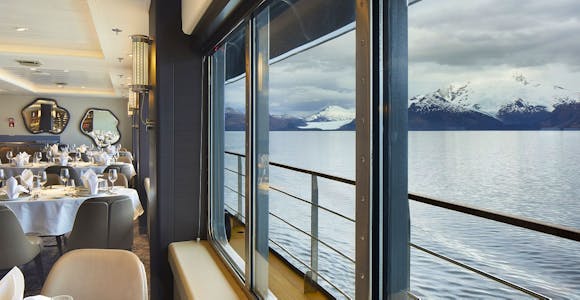
This guide will show you what to expect from the practical side of expedition cruising and what day-to-day life will look like on board your ship.
Discover More